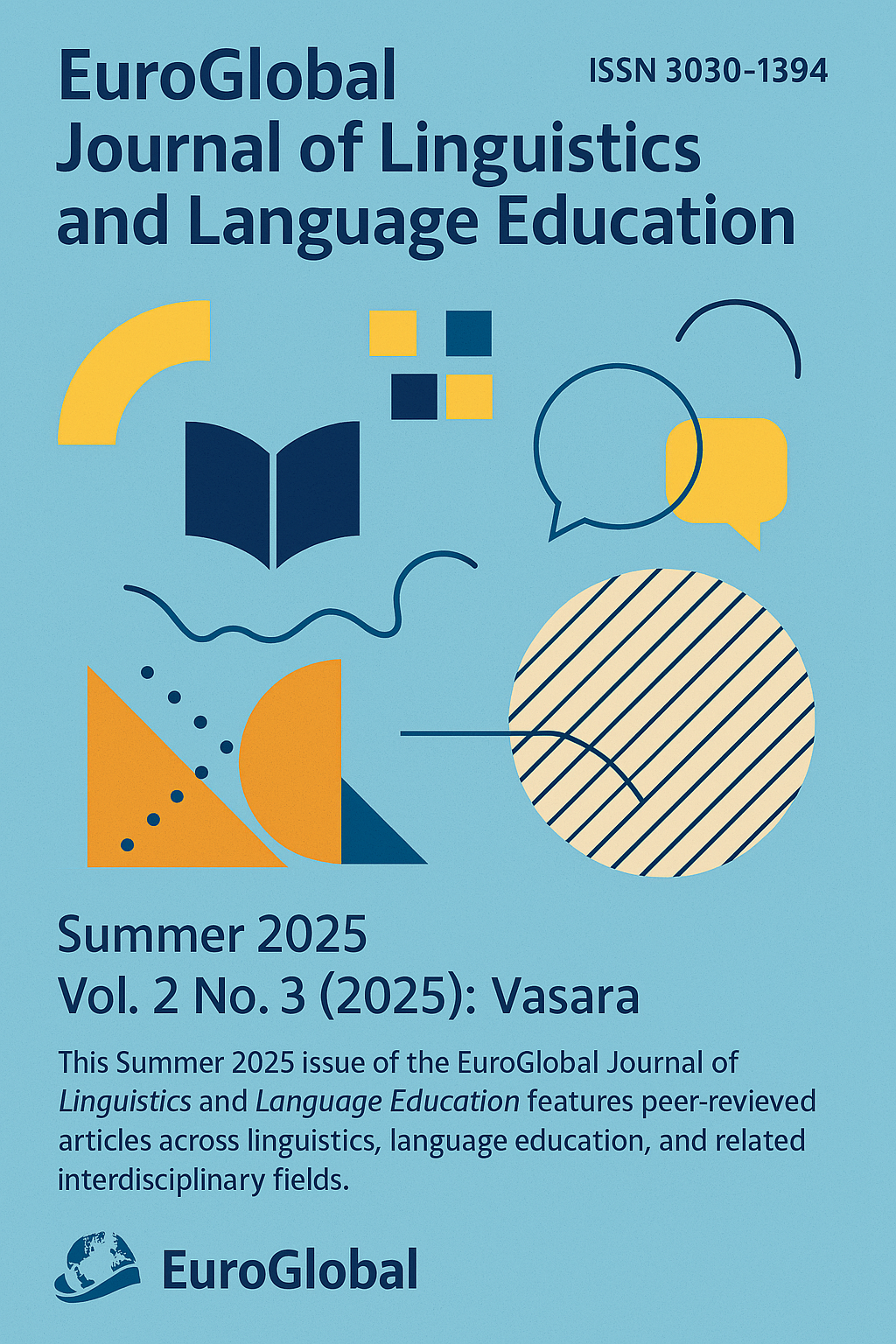Machine Learning Approaches for Automated Vocabulary Acquisition in ESL Classrooms
DOI :
https://doi.org/10.69760/egjlle.2500202Mots-clés :
ESL vocabulary learning, BERT, transformer models, supervised learning, reinforcement learning, educational technologyRésumé
Purpose: This study investigates the efficacy of machine learning (ML) approaches for automated vocabulary acquisition in English as a Second Language (ESL) classrooms. It focuses on transformer-based models (specifically BERT), comparing their performance to traditional supervised algorithms and examining effects on learner vocabulary gains. Methods: University-level ESL students in Azerbaijan (N = 60) participated in an experiment with an ML-driven vocabulary learning tool. A pre-trained BERT model was fine-tuned via TensorFlow for vocabulary prediction tasks and deployed to personalize practice for an experimental group, while a control group received conventional instruction. Support Vector Machine (SVM) and Random Forest models served as baseline algorithms for predictive performance benchmarking. Vocabulary knowledge was assessed pre- and post-intervention using standardized tests, and ML models were evaluated on accuracy, precision, and recall. Results: The fine-tuned BERT model achieved higher predictive accuracy (88%) than SVM (75%) or Random Forest (78%), with superior precision and recall. The experimental group outperformed the control on post-test vocabulary gains (mean improvement = 10.1 vs. 5.7 words, p < .01). Implications: Results indicate that transformer-based ML can enhance vocabulary learning outcomes, offering context-aware recommendations that surpass traditional models. We discuss how deep neural networks and reinforcement learning techniques can be integrated into ESL pedagogy to support adaptive vocabulary instruction. The study contributes a framework for applying state-of-the-art ML in language education and highlights implications for personalized learning and curriculum design.
Références
Alanzi, A. A., & Taloba, A. I. (2024). Gamification and deep learning-driven transformer feedback mechanism for adaptive language learning assessment. Paper presented at the 5th International Conference on Smart Learning Environments (ICSLE 2024). (Forthcoming conference paper, abstract retrieved from ResearchGate.)
Basal, A., Yilmaz, S., Tanriverdi, A., & Sari, L. (2016). Effectiveness of mobile applications in vocabulary teaching. Contemporary Educational Technology, 7(1), 47–59. https://doi.org/10.30935/cedtech/6162
Burston, J. (2015). Twenty years of MALL project implementation: A meta-analysis of learning outcomes. ReCALL, 27(1), 4–20. https://doi.org/10.1017/S0958344014000159
Chen, C. M., & Chung, C. J. (2008). Personalized mobile English vocabulary learning system based on item response theory and learning memory cycle. Computers & Education, 51(2), 624–645. https://doi.org/10.1016/j.compedu.2007.06.011
Chen, Y., & Choi, Y. (2021). Incorporating AI into English vocabulary learning: A review of current practices and future directions. Journal of Educational Technology & Society, 24(1), 184–197. (No DOI available.)
Devlin, J., Chang, M. W., Lee, K., & Toutanova, K. (2019). BERT: Pre-training of deep bidirectional transformers for language understanding. In Proceedings of NAACL-HLT 2019 (pp. 4171–4186). Association for Computational Linguistics. https://doi.org/10.48550/arXiv.1810.04805
Dudiak, D., Szabóová, M., & Magyar, J. (2023). Exploring Q-learning in social robots for English–Slovak vocabulary learning. In Proceedings of the 23rd IEEE International Symposium on Computational Intelligence and Informatics (CINTI 2023) (pp. 000027–000032). IEEE. https://doi.org/10.1109/CINTI59972.2023.10382107
Ebadi, S., & Amini, A. (2022). Examining the roles of social presence and human-likeness on Iranian EFL learners’ motivation using artificial intelligence technology: A case of CSIEC chatbot. Interactive Learning Environments. Advance online publication. https://doi.org/10.1080/10494820.2022.2096638
Godwin-Jones, R. (2018). Contextualized vocabulary learning. Language Learning & Technology, 22(3), 1–19. (No DOI – available at University of Hawai‘i ScholarSpace: http://hdl.handle.net/10125/44651.)
Hsu, T., Chang, C., & Jen, T. (2023). Artificial intelligence image recognition using self-regulation learning strategies: Effects on vocabulary acquisition, learning anxiety, and learning behaviours of English language learners. Interactive Learning Environments, 32(6), 3060–3078. https://doi.org/10.1080/10494820.2023.2165508
Küçük, Z., & Solmaz, E. (2021). Language learning and teaching applications of artificial intelligence. Hacettepe University Journal of Education, 36(4), 1217–1232. (No DOI available.)
Nation, I. S. P. (2013). Learning vocabulary in another language (2nd ed.). Cambridge University Press.
Schmitt, N. (2008). Review article: Instructed second language vocabulary learning. Language Teaching Research, 12(3), 329–363. https://doi.org/10.1177/1362168808089921
Tsai, Y. L., & Tsai, C. C. (2018). Digital game-based second-language vocabulary learning and conditions of research designs: A meta-analysis study. Computers & Education, 125, 345–357. https://doi.org/10.1016/j.compedu.2018.06.020
Wang, Y. (2024). Construction and improvement of an English vocabulary learning model integrating spiking neural networks and convolutional long short-term memory algorithms. PLoS ONE, 19(3), e0299425. https://doi.org/10.1371/journal.pone.0299425
Wu, Z., Larson, E. C., Sano, M., Baker, D., Gage, N., & Kamata, A. (2023). Towards scalable vocabulary acquisition assessment with BERT. In Proceedings of the 10th ACM Conference on Learning@Scale (L@S ’23) (pp. 272–276). ACM. https://doi.org/10.1145/3573051.3596170
Xie, Q., He, Z., & Freeman, G. (2018). Harnessing collective intelligence for L2 vocabulary learning: Examining the influence of a crowdsourcing-based approach. Computer Assisted Language Learning, 31(5–6), 617–644. https://doi.org/10.1080/09588221.2018.1441367
Zawacki-Richter, O., Marín, V. I., Bond, M., & Gouverneur, F. (2019). Systematic review of research on artificial intelligence applications in higher education – where are the educators? International Journal of Educational Technology in Higher Education, 16(39), 1–27. https://doi.org/10.1186/s41239-019-0171-0
Zhao, Y., Muhamad, M. M., Mustakim, S. S., Li, W., & Wang, A. (2023). Intelligent recommender systems in mobile-assisted language learning (MALL): A study of BERT-based vocabulary learning. In Proceedings of the 2023 International Conference on Mobile Networks and Wireless Communications (ICMNWC). IEEE. https://doi.org/10.1109/ICMNWC60182.2023.10435740
Zhang, T., & Li, C. (2024). Adaptive English vocabulary recommendation systems: A computational intelligence approach using deep reinforcement learning. In Proceedings of SPIE Vol. 13550, Sixth International Conference on Education and Training Technologies. SPIE. https://doi.org/10.1117/12.3059790
Zheng, L., Niu, J., Zhong, L., & Gyasi, J. (2022). The effectiveness of artificial intelligence on learning achievement and learning perception: A meta-analysis. Interactive Learning Environments, 30(8), 1551–1567. https://doi.org/10.1080/10494820.2021.2015693
Téléchargements
Publié
Numéro
Rubrique
Licence
© EuroGlobal Journal of Linguistics and Language Education 2025

Cette œuvre est sous licence Creative Commons Attribution - Pas d'Utilisation Commerciale - Pas de Modification 4.0 International.





